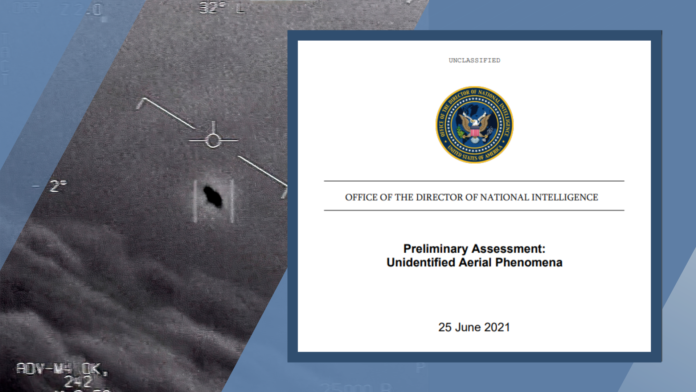UAP stands for Unidentified Aerial Phenomena. It replaces the more familiar term UFO which has been in public purview since just after World War II. Two weeks ago I published two articles on this subject, one a summation of media reports in the U.S. about government disclosures related to these phenomena, and the second describing China’s perspective on the same subject.
Now in a report to the U.S. Congress, the Office of the Director of National Intelligence has attempted to assess the phenomena. It begins by stating there isn’t enough hard data to draw firm conclusions about what UAPs are. Of course, that’s the mystery in all of this. We have visual evidence of objects captured by sensors, radar, infrared, electro-optical, and visual observation. Military pilots have even locked weapons on the phenomena but have never fired.
The one thing that is clear is the high degree of variability in sightings. Some UAPs have exhibited flight characteristics that have been deemed unusual. The report notes the human and equipment capture observations “could be the result of sensor errors, spoofing, or observer misperception.”
The report notes that the observed data fit five categories:
- Airborne Clutter – objects could be balloons, birds, recreational drones, and airborne debris like plastic bags.
- Natural Atmospheric Phenomena – objects could be ice crystals, moisture, and thermal fluctuations that register on radar and infrared sensors.
- U.S. Government or Industry Development Programs – objects seen could be attributed to programs both commercial and military.
- Foreign Adversary Systems – objects could be technology attributed to China, Russia, another nation or a non-government player.
- Other – the largest dataset displaying characteristics that current scientific and technological knowledge cannot explain.
The report does conclude that UAPs pose a flight safety risk for U.S. national security based on firsthand witnessing between 2004 and 2021. Only one of 144 reports of this nature has been demystified as attributable to a large deflating balloon. The vast majority of the remaining reports come from the U.S. Navy, and 80 have involved multiple sensor observations near military facilities interrupting preplanned training and other activity. In 21 reports involving 18 incidents, the UAPs have exhibited extraordinary flight characteristics that don’t correspond to any current U.S. engineering capabilities. These include UAPs that remain stationary even in high winds, change directions abruptly, travel at high speed, and exhibit no discernible means of propulsion. In a number of cases, sensors have recorded radio frequency (RF) energy signals emanating from the objects.
Whenever we see UAPs on film they appear fuzzy or indistinct. Why is this? Because the sensors and cameras used by military aircraft have specific mission purposes which are really unsuited to identify what UAPs really are? If we are to unravel the mystery, therefore, we need to close this technology gap and develop sensors and cameras that give us a clear picture and understanding of what we are observing.
That national security concludes UAPs are a flight safety risk shouldn’t be surprising. As reported, if UAPs represent an advanced technology from a foreign adversary, then they are indeed a military risk. And the fact that most appear in airspaces over military restricted areas lends to this concern. Of course, the limited dataset skews to military sightings in this report rather than to commercial ones. This deficiency needs to be addressed. And as a final risk, UAPs pose a distraction to military pilots with some reporting near misses when the objects suddenly change direction or fly directly at or by them at high speeds.
What the Preliminary Report Recommends
Because the majority of reports have come from one branch of the U.S. armed services, the navy, it is imperative that incidents from other service branches and government agencies, as well as reports from accredited civilian sources, such as the FAA, be captured using standardized incident reporting.
In November 2020, the U.S. Airforce began a six-month pilot program to collect and evaluate UAP encounters. This is part of an expanded effort to increase knowledge of UAPs and eliminate the current navy bias in the dataset. The FAA is also to encourage the reporting of UAPs by civilian and commercial aircraft operators. There is no mention of a standard dataset for the latter. But it is likely that a baseline for both military and civilian observations will emerge. For this purpose, the report recommends additional funding to study UAPs.
The U.S. Senate has requested a more comprehensive report be put together that includes:
- Detailed analysis of UAP data and intelligence reporting collected or held by the
Naval Intelligence. - Detailed analysis of unidentified phenomena data collected by:
a. Geospatial Intelligence;
b. Signals Intelligence;
c. Human Intelligence; and
d. Measurement and Signatures Intelligence. - Detailed analysis of FBI data derived from investigations of UAP events over restricted U.S. airspace.
- Details of an interagency process to ensure timely data collection and centralized analysis of all UAP reporting with the appointment of a single point person to head up the interagency effort.
- Identification of potential aerospace or other threats posed by UAPs to national
security, with an assessment of whether the phenomena can be attributed to one or
more foreign adversaries. - Identification of any incidents or patterns indicating a potential adversary has
achieved breakthrough aerospace capabilities that put U.S. strategic or
conventional forces at risk. - Recommendations regarding additional data collection requirements, enhanced research and development, and additional funding requirements.
So what can we conclude from this big government reveal? We know some of the things we think are UAPs are explainable. But a significant majority of sightings and incidents classified as “other” are not. Or to paraphrase a former U.S. Defense Secretary, “there are known knowns and known unknowns, and we don’t know what we don’t know.” That’s why the U.S. Senate is recommending the government throw some money at UAP sightings to turn unknowns into knowns and unravel the mystery.
















